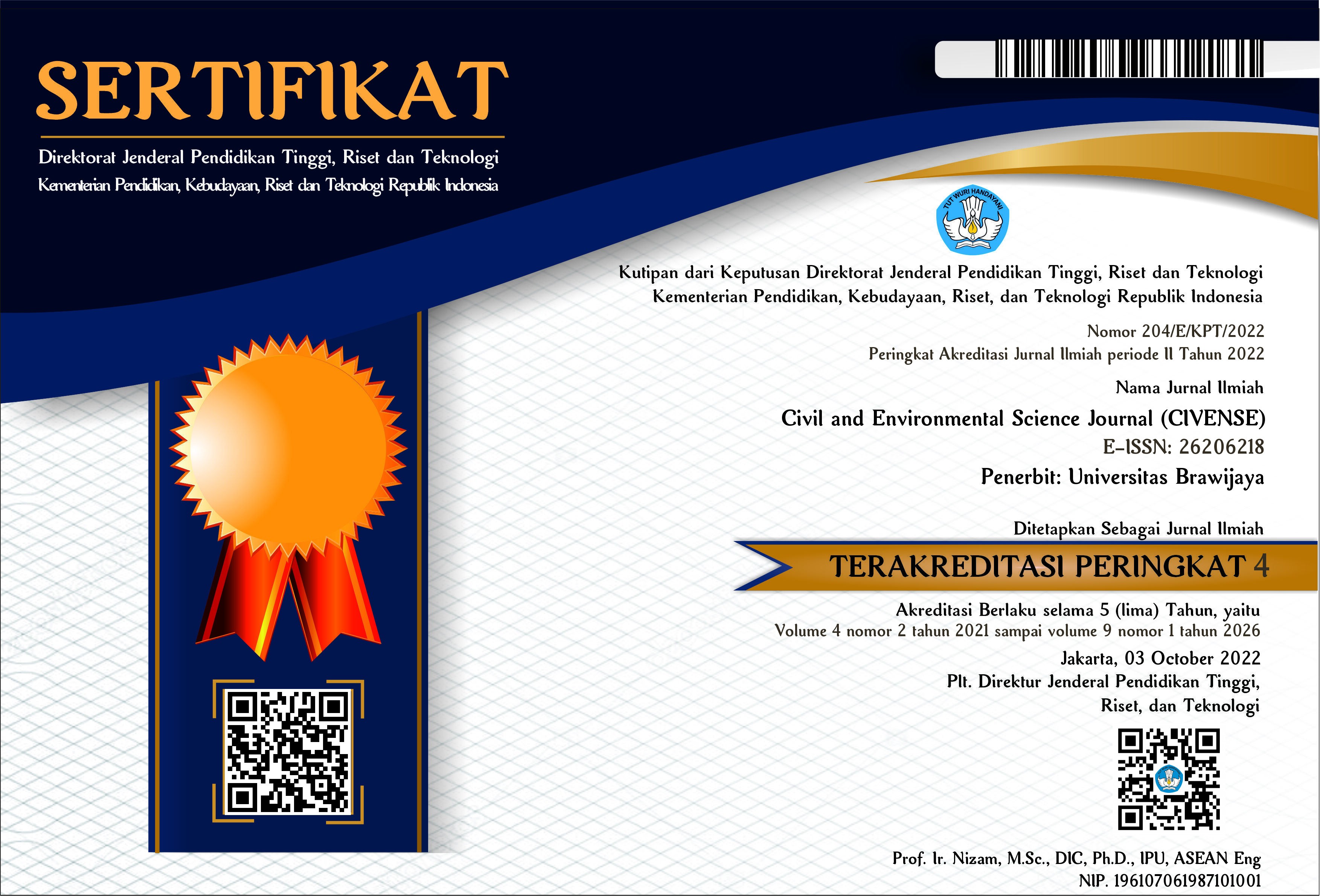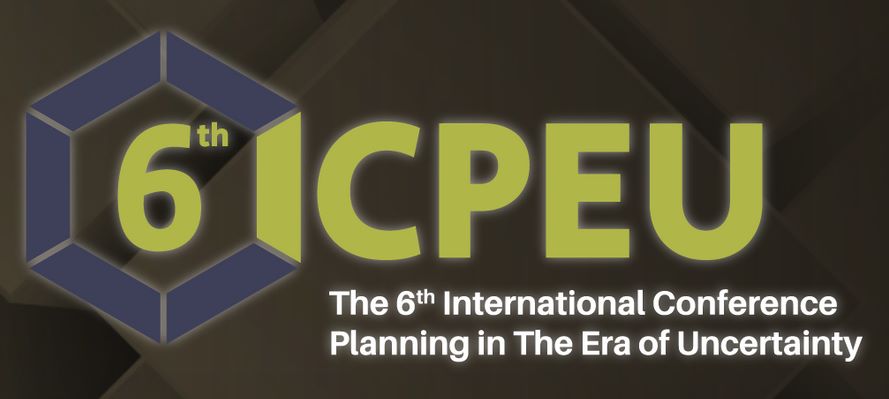Performance of The Dispin Models with Automatic Parameter Calibration on The Transformation of Rainfall to Runoff Data
DOI:
https://doi.org/10.21776/ub.civense.2019.00202.2Keywords:
automatic, calibration, disprin model, rainfall-runoffAbstract
This article presents a new model of the DISPRIN Model combination with two different level optimization methods. The new model of DISPRIN Model combination and Differential Evolution (DE) algorithm is called DISPRIN25-DE Models and its incorporation with Monte Carlo Simulation method called DISPRIN25-MC Models. The case study is Lesti Watershed (319.14 Km2) in East Java. The model test uses a 10-year daily data set, from January 1, 2007 to December 31, 2016. Data series Year 2007 ~ 2013 as a set of training data for calibration and data Year 2014 ~ 2016 as testing data set for model validation. Running program DISPRIN25-DE Models with input parameter value C_min = 0, C_max = 1, H_min = 0, H_max = 600 mm obtained best fitness 0.044 m3/sec, NSE = 0.762 and PME = -0.059. The DISPRIN25-MC Models analysis generates a minimum RMSE of 0.056 m3/sec, NSE = 0.779, PME = -0.70. From the RMSE and NSE indicators it appears that both models can show an equivalent level of performance, but in terms of the PME indicator and iteration time is apparent The DISPRIN25-MC model has worse performance than the two DISPRIN25-DE models.
References
Bao H. J, Wang L, Li Z. J, Zao L. N, Guo-ping ZHANG, 2008, Hydrological daily rainfall-runoff simulation with BTOPMC model and comparison with Xin’anjiang model, Water Science and Engineering, 2010, 3(2): 121-131, doi: 10.3882/j.issn.1674-2370.2010.02.001, http://www.waterjournal.cn, e-mail: wse2008@vip.163.com
Budi Santosa & Paul Willy, 2011, Metoda Metaheuristik Konsep dan implementasi, Cetakan pertama, Guna Widya, Surabaya, Indonesia.
Chen C, Shrestha D.L., Perez G.C., Solomatine D., 2006, Comparison of methods for uncertainty analysis of hydrologic models, 7th International Conference on Hydroinformatics HIC 2006, Nice, FRANCE.
Darikandeh Dorsa, Akbarpour Abolfazl, Bilondi Mohsen Pourreza & Hashemi Seyyed Reza, 2014, Automatic calibration for Estimation of The Parameters of Rainfall - Runoff Model, SCIJOUR, Journal of River Engineering, Volume 2, Issue 8 2014, http://www.scijour.com/jre.
Gupta, Sorooshian & Yapo, 1999, “Status of automatic calibration for hydrologic Models: Comparation With Multi Level Expert Calibration”, Journal of Hydrologic Engineering, Vol. 4, No. 2, April, 1999. ASCE, ISSN:1084-0699/99/0002-0135–0143, http://www.ascelibrary.org.
Huang X. L. & Xiong J., 2010, Parameter Optimization of Multi-Tank Model with Modified Dynamically Dimensioned Search Algorithm, Proceedings of the Third International Symposium on Computer Science and Computational Technology (ISCSCT ’10), Jiaozuo, P. R. China, 14-15, August 2010, pp. 283-288, ISBN 978-952-5726-10-7, © 2010 ACADEMY PUBLISHER, AP-PROC-CS-10CN007.
Hsu & Yeh, 2015, Study on Flood Para-Tank Model Parameters with Particle Swarm Optimization, Journal of Information Hiding and Multimedia Signal Processing, Ubiquitous International Volume 6, Number 5, September 2015, @ 2015 ISSN 2073-4212
Jonsdottir Harpa, Madsen Henrik & Palsson Olafur Petur, 2005, Parameter estimation in stochastic rainfall-runoff models, ELSEVIER, Journal of Hydrology 326 (2006) 379–393.
Kenji T.,Yuzo O.,Xiong J. & Koyama T, 2008, Tank Model and its Application to Predicting Groundwater Table in Slope, Chinese Journal of Rock Mechanics and Engineering, Vol.27 No.12 Dec,2008, CLC number:P 642.22 Document code:A Article ID:1000–6915(2008)12–2501–08.
Kim Oong H., Paik Kyung R., Kim Hung S. & Lee, 2005 Dong R., A Conceptual Rainfall – runoff Model Considering Seasonal Variation, ARTICLE in HYDROLOGICAL PROCESSES · DECEMBER 2005Impact Factor: 2.68 · DOI: 10.1002/hyp.5984ADVANCES IN HYDRO-SCIENCE AND –ENGINEERING, VOLUME VI, http://www.researchgate.net/publication/ 227599393
Kuok King Kuok, Sobri Harun and Po-Chan Chiu, 2011, Comparison of Particle Swarm Optimization and Shuffle Complex Evolution for Auto-Calibration of Hourly Tank Model’s Parameters, Int. J. Advance. Soft Comput. Appl., Vol. 3, No. 3, November 2011, ISSN 2074-8523; Copyright © ICSRS Publication, 2011, www.i-csrs.org
M. Shaw, Elizabeth, 1985, Hydrology in Practice, Van Nostrand Reinhold (UK) Co. Ltd.
Ngoc T. A., Hiramatsu K. & Haramada M., 2012, Optimizing Parameters for Two Conceptual Hydrological Models Using a Genetic Algorithm: A Case Study in the Dau Tieng River Watershed, Vietnam, JARQ 47 (1), 85 – 96 (2013) http://www.jircas.affrc.go.jp.
Ramires J.D, Camacho R, McAnally W, Martin J, 2012, Parameter uncertainty methods in evaluating a lumped hydrological model, Obrasy Proyectos 12, 42-56.
Saibert Jan, 2000, Multi-criteria Calibration of Conceptual Runoff Model Using a Genetic Algorithm, Hydrology and Earth System Sciences, 4(2), 215-224 (2000) EGS.
Santos, 2011, Application of a particle swarm optimization to the Tank Model, Risk in Water Resources Management (Proceedings of Symposium H03 held during IUGG2011 in Melbourne, Australia, July 2011) (IAHS Publ. 347, 2011).
Setiawan B., Fukuda T. & Nakano Y., 2003, Developing Procedures for Optimization of Tank Model’s Parameters, Agricultural Engineering International: the CIGR Journal of Scientific Research and Development.
Tolson B. A. & Shoemaker C. A., 2007, Dynamically dimensioned search (DDS) algorithm for computationally efficient watershed model calibration, ATER RESOURCES RESEARCH, VOL. 43, W01413, doi:10.1029/2005WR004723, 2007, Copyright 2007 by the American Geophysical Union. 0043-1397/07/2005WR004723$09.00
Uhlenbrook S, Seibert J, Leibundgut C, Rodhe A, 1999, Prediction uncertainty of conceptual rainfallrunoff models caused by problems in identifying model parameters and structure, Hydrological Sciences-Joumal-des Sciences Hydrologiques, 44(5) October.
Wang W. C., Cheng C. T., Chau K. W & Xu D. M., 2012, Calibration of Xinanjiang model parameters using hybrid genetic algorithm based fuzzy optimal model, © IWA Publishing 2012, Journal of Hydroinformatic, 14.3 – 2012, 785 W.-C. Wang et al. | Calibration of Xinanjiang model parameters using HGA based FOM.
Zhang, Srinivasan, Zhao & Liew (2008), Evaluation of global optimization algorithms for parameter calibration of a computationally intensive hydrologic model, HYDROLOGICAL PROCESSES, Published online in Wiley InterScience, www.interscience.wiley.com.
Downloads
Published
How to Cite
Issue
Section
License
Copyright (c) 2019 Civil and Environmental Science Journal

This work is licensed under a Creative Commons Attribution-NonCommercial 4.0 International License.
Authors who publish with this journal agree to the following terms:
Authors retain copyright and grant the journal right of first publication with the work simultaneously licensed under a Attribution-NonCommercial 4.0 International License that allows others to share the work with an acknowledgement of the work's authorship and initial publication in this journal.
Authors are able to enter into separate, additional contractual arrangements for the non-exclusive distribution of the journal's published version of the work (e.g., post it to an institutional repository or publish it in a book), with an acknowledgement of its initial publication in this journal.
Authors are permitted and encouraged to post their work online (e.g., in institutional repositories or on their website) prior to and during the submission process, as it can lead to productive exchanges, as well as earlier and greater citation of published work (See the Effect of Open Access).














